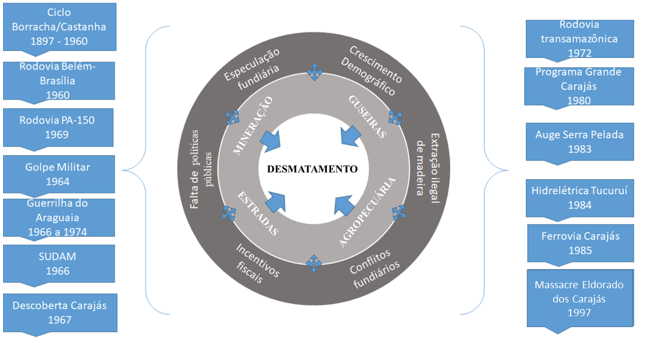Historical factors associated with forest conversion in the Carajás region
DOI:
https://doi.org/10.37002/biodiversidadebrasileira.v15i1.2698Keywords:
Socio-environmental, policy , territory , communitiesAbstract
The history of deforestation in the Carajás region has led to the geographic isolation of protected areas. Understanding the drivers associated with this process is crucial for planning strategies to mitigate impacts and promote a transition toward sustainability. In light of this, the aim of this article is to evaluate the historical, socioeconomic, political, and environmental factors associated with forest conversion around the conservation units of Carajás. To this end, the methodology was divided into three stages: (1) literature review, (2) document analysis, and (3) semi-structured interviews. In this way, historical data were compiled on deforestation, land management, land tenure, economy, demography, and environmental regulation. Direct drivers of the deforestation process were identified as: (1) mining; (2) agricultural expansion; (3) road and infrastructure construction; (4) pig iron production. Indirect drivers included: (1) population growth; (2) tax incentives; (3) land conflicts; (4) illegal logging; (5) lack of public policies; and (6) land speculation. Regarding these aspects, it is worth highlighting the dependence of the local economy on exogenous factors related to global commodity trade and the demographic flows associated with this process. Another significant element was the pronounced history of unequal conflicts over access to natural resources. Thus, it can be concluded that the underlying factors of forest loss around the protected areas of Carajás are linked to a historical development agenda that gave rise to powerful physical, institutional, cultural, and political structures, which have driven mining, agriculture, and illegal logging.
Downloads
References
1. Aldrich S, Walker R, Simmons C, Caldas M, Perz S. Contentious land change inthe Amazon’s arc of deforestation. Annals of the Association of American Geographers; 2012. DOI: https://doi.org/10.1080/00045608.2011.620501
2. Schmink M, Hoelle J, Gomes C, Thaler G. From contested to ‘green’ frontiers in the Amazon? A long-term analysis of São Félix do Xingu, Brazil. The Journal of Peasant Studies; 2017. DOI: https://doi.org/10.1080/03066150.2017.1381841
3. Pinheiro T F, Escada MSI, Valeriano DM, Hostert P, Gollonow F, Muller U. Forest Degradation Associated with Logging Frontier Expansion in the Amazon: the BR-163 Region in Southwestern Para. Earth Interactions, Brazil; 2016. DOI: https://doi.org/10.1175/EI-D-15-0016.1
4. Laurance WF, Goosem M, Laurance SG. Impacts of roads and linear clearings on tropical forests. Trends Ecol. Evol; 2009. DOI: https://doi.org/10.1016/j.tree.2009.06.009
5. Müller-Hansen F, Heitzig J, Donges JF, Cardoso MF, Dalla-Nora EL, Andrade P; Thonicke K. Can intensification of cattle ranching reduce deforestation in the Amazon? Insights from an agent-based social-ecological model. Ecol. Econ; 2019. DOI: https://doi.org/10.1016/j.ecolecon.2018.12.025
6. Brandt JS, Nolte C, Agrawal, A. Deforestation and timber production in Congo after implementation of sustainable forest management policy. Land Use Pol; 2016. DOI: https://doi.org/10.1016/j.landusepol.2015.11.028
7. Assunção J, Gandour C, Rocha R, Rocha R. The effect of rural credit on deforestation: evidence from the Brazilian Amazon. Econ. J; 2020. DOI: https://doi.org/10.1093/ej/uez060
8. Reydon BP, Fernandes, VB, Telles TS. Land governance as a precondition for decreasing deforestation in the Brazilian Amazon. Land Use Pol; 2019. DOI: https://doi.org/10.1016/j.landusepol.2019.104313
9. Pichón FJ, Settler households and land-use patterns in the Amazon frontier: farm-level evidence from Ecuador. World Dev; 1997. DOI: https://doi.org/10.1016/S0305-750X(96)00091-5
10. Yanai AM, Graça PMLA, Escada MIS, Ziccardi LG, Fearnside PM. Deforestation dynamics in Brazil’s Amazonian settlements: effects of land-tenure concentration. J. Environ. Manag; 2020. DOI: https://doi.org/10.1016/j.jenvman.2020.110555
11. Benyishay A, Heuser S, Runfola D, Trichler R. Indigenous land rights and deforestation: evidence from the Brazilian Amazon. J. Environ. Econ. Manag; 2017. DOI: https://doi.org/10.1016/j.jeem.2017.07.008
12 Rudke AP, Sikora SVA, Santos AMD, Freitas XAC, Rotunno FOC, Martins JA. Impact of mining activities on areas of environmental protection in the southwest of the Amazon: a GIS- and remote sensing-based assessment. J. Environ. Manag; 2020. DOI: https://doi.org/10.1016/j.jenvman.2020.110392
13. Souza FPWM, Souza EB, Silva JRO, Nascimento WRJ, Mendonça BRV, Guimarães TF, Dall’agnol R, Siqueira JO. Four decades of land-cover, land-use and hydroclimatology changes in the Itacaiúnas River watershed, southeastern Amazon. Journal of Environmental Management; 2016.
14. Fearnside PM. Deforestation of the Brazilian Amazon. In: Shugart, H. (Ed.), Oxford Research Encyclopedia of Environmental Science. Oxford University Press, New York, USA; 2017. DOI: https://doi.org/10.1093/acrefore/9780199389414.013.102
Murray PR, Rosenthal KS, Kobayashi GS, Pfaller MA. Medical microbiology. 4th ed. St. Louis: Mosby; 2002.
15. Triviños ANS, Introdução à Pesquisa em Ciências Sociais - A pesquisa qualitativa em educação; 1987.
16. Braun V, Clark V, Using thematic analysis in psychology. Qualitative Research; 2006. DOI: https://doi.org/10.1191/1478088706qp063oa
17. Velho OG Frentes de expansão e estrutura agrária: estudo do processo de penetração numa área da Transamazônica. Centro Edelstein de Pesquisas Sociais, Rio de Janeiro, Brasil, 2009. 172p. DOI: https://doi.org/10.7476/9788599662915
18. Hébette J, Marin REA. A ligação rodoviária norte-sul: Sonhos e realidade. In: Hébette J, editor. Cruzando a Fronteira: 30 Anos de Estudo do Campesinato na Amazônia: Volume I - Colonização e ilusões de desenvolvimento. Belém: UFPA; 2004. P. 36-38.
19. Simmons CS, Walker R, Aldrich S, Arima E, Pereira R, Castro EMR de, Michelotti F, Waylen M, Antunes A. Discipline and Develop: Destruction of the Brazil Nut Forest in the Lower Amazon Basin. Annals of the American Association of Geographers; 242-65, 2019. DOI: https://doi.org/10.1080/24694452.2018.1489215
20. Emmi MF. Os castanhais do Tocantins e a indústria extrativa no Pará até a década de 60. Paper do NAEA. 2002;11. DOI: https://doi.org/10.18542/papersnaea.v11i1.11631
21. Bentes RDS, Marín RA, Emmi MF. Os cemitérios das castanheiras do Tocantins. Pará Desenvolvimento. 1988;23:18-23.
22. Homma AKO, Carvalho R, Ferreira CA, Nascimento JDN. A destruição de recursos naturais: O caso da castanha-do-pará no Sudeste Paraense. Belém: Embrapa Amazônia Oriental; 2000. (Documentos, 32).
23. Aramburu MA. Aviamento, modernidade e pós-modernidade na Amazônia. Revista Brasileira de Ciências Sociais. 1994;25.
24. Simmons CS, Walker RT, Arima EA, Aldrich SP, Caldas MM. The Amazon land war in the south Pará. Annals of the American Association of Geographers. 2007;97:567-92.
25. Kitamura PC, Muller C. Castanhais nativos de Marabá, PA: Fatores de depredação e bases para a sua preservação. Belém: EMBRAPA; 1984.
26. IBGE. Pesquisa de Informações Básicas Municipais: Perfil dos Municípios Brasileiros. Rio de Janeiro: IBGE; 2010.
27. Buclet B. Entre tecnologia e escravidão: a aventura da Volkswagen na Amazônia. O Social em Questão. Rio de Janeiro: PUC/Rio; 2005;13:5.
28. Acker A. O maior incêndio do planeta: como a Volkswagen e o regime militar brasileiro acidentalmente ajudaram a transformar a Amazônia em uma arena política global. Revista Brasileira de História. 2014;34(68):13-33. DOI: https://doi.org/10.1590/S0102-01882014000200002
29. Santos AFG dos. Amazônia, propaganda e publicidade. Faces da História. 2019; 6:459-77.
30. Morais T, Silva E. Operação Araguaia: Os arquivos secretos da guerrilha. São Paulo: Geração Editorial; 2005.
31 Simmons CS, Walker RT, Arima EA, Aldrich SP, Caldas MM. The Amazon land war in the south Pará. Annals of the American Association of Geographers. 2007;97:567-92. DOI: https://doi.org/10.1111/j.1467-8306.2007.00564.x
32. IBAMA. Plano de Manejo para Uso Múltiplo da Floresta Nacional de Carajás. Curitiba: STCP Engenharia de Projetos LTDA; 2003.
33. Palheta JM, Silva CN, Oliveira-Neto A, Nascimento FR. Conflitos pelo uso do território na Amazônia mineral. Mercator. 2017;16:1-18. DOI: https://doi.org/10.4215/rm2017.e16023
34. Schmink M, Wood CH. Contested frontiers in Amazonia. New York: Columbia University Press; 1992.
35. INCRA. 2022. Assentamentos Rurais da Reforma Agrária 2003. [acesso em abr de 2022]. Disponível em: http://painel.incra.gov.br/sistemas/index.php.
36. Comissão Pastoral da Terra (CPT). 2015 e 2016. Conflitos no Campo Brasil. [acesso em 22 abril 2022]. Disponível em: https://www.cptnacional.org.br/.
37. Brasil. Comissão Nacional da Verdade. Mortos e desaparecidos políticos. Brasília, DF: CNV; 2014. p.1836-41. (Relatório da Comissão Nacional da Verdade, 3).
38. Homma AKO. Extrativismo vegetal ou plantio: qual a opção para a Amazônia? In: Homma AKO, editor. Extrativismo vegetal na Amazônia: história, ecologia, economia e domesticação. Brasília: Embrapa; 2014. p.17-43.
39. Homma AKO, Alves RNB, Menezes AJEA, Matos GB. Guseiras na Amazônia: perigo para a floresta. Ciência Hoje. 2006;39:56-9.
40. Hecht SB, Rajão R. From “Green Hell” to “Amazonia Legal”: land use models and the reimagination of the rainforest as a new development frontier. Land Use Policy. 2020;96. DOI: https://doi.org/10.1016/j.landusepol.2019.02.030
41. Klingler M, Mack P. Post-frontier governance up in smoke? Free-for-all frontier imaginations encourage illegal deforestation and appropriation of public lands in the Brazilian Amazon. Journal of Land Use Science. 2020;15(2-3):424-38. DOI: https://doi.org/10.1080/1747423X.2020.1739765
42. Li G, Lu D, Moran E, Calvi MF, Dutra V, Batistella M. Examining deforestation and agropasture dynamics along the Brazilian Transamazon Highway using multitemporal Landsat imagery. GIScience Remote Sens. 2019;56:161-83. DOI: https://doi.org/10.1080/15481603.2018.1497438
43. Santos VM. A Economia do Sudeste Paraense: Evidências das transformações estruturais. In: Desenvolvimento Regional no Brasil: políticas, estratégias e perspectivas. Brasília: IPEA (Instituto de Pesquisa Econômica Aplicada); 2017.
44. Moutinho P, Guerra R, Azevedo-Ramos C. Achieving zero deforestation in the Brazilian Amazon: What is missing? Elem Sci Anthr. 2016;4. DOI: https://doi.org/10.12952/journal.elementa.000125
45. Alston LJ, Libecap GD, Mueller B. Land reform policies, the source of violent conflict, and implications for deforestation in the Brazilian Amazon. J Environ Econ Manage. 2000;39:162-88. DOI: https://doi.org/10.1006/jeem.1999.1103
46. Rajão R, Soares-Filho B, Börner J, Machado L, Assis D, Oliveira A, Pinto L, Ribeiro V, Rausch L, Gibbs H, Figueira D. The rotten apples of Brazil’s agribusiness. Science. 2020;369:246-8. DOI: https://doi.org/10.1126/science.aba6646
47. Parry L, Day B, Amaral S, Peres CA. Drivers of rural exodus from Amazonian headwaters. Popul Environ. 2010;32:137-76. DOI: https://doi.org/10.1007/s11111-010-0127-8
48. Carrero GC, Fearnside PM. Forest clearing dynamics and the expansion of landholdings in Apuí, a deforestation hotspot on Brazil’s Transamazon highway. Ecol Soc. 2011;16. DOI: https://doi.org/10.5751/ES-04105-160226
49. Soares-Filho BS, Nepstad DC, Curran LM, Cerqueira GC, Garcia RA, Ramos CA, Voll E, McDonald A, Lefebvre P, Schlesinger P. Modeling conservation in the Amazon Basin. Nature. 2006;440:520-3. DOI: https://doi.org/10.1038/nature04389
50. Barber CP, Cochrane MA, Souza Jr CM, Laurance WF. Roads, deforestation, and the mitigating effect of protected areas in the Amazon. Biol Conserv. 2014;177:203-9. DOI: https://doi.org/10.1016/j.biocon.2014.07.004
51. Vieira ALM, Ribeiro KT, Quirino GRS, Louzada R, Mariz RG, Martins FD. Mosaico Carajás: Perspectivas de Ampliação da Conservação. In: Martins FF, Kamino LHY, Ribeiro KT, editores. Projeto Cenários Conservação de Campos Ferruginosos diante da Mineração em Carajás. Tubarão: Copiart; 2018. p.455-67

Downloads
Published
Issue
Section
License
Copyright (c) 2025 Os autores mantêm os direitos autorais de seus artigos sem restrições, concedendo ao editor direitos de publicação não exclusivos.

This work is licensed under a Creative Commons Attribution-NonCommercial-NoDerivatives 4.0 International License.
Os artigos estão licenciados sob uma licença Creative Commons Atribuição-NãoComercial-SemDerivações 4.0 Internacional (CC BY-NC-ND 4.0). O acesso é livre e gratuito para download e leitura, ou seja, é permitido copiar e redistribuir o material em qualquer mídia ou formato.











